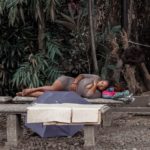Protecting the last refuges of nature

“The health of ecosystems on which we and all other species depend is deteriorating more rapidly than ever. We are eroding the very foundations of our economies, livelihoods, food security, health and quality of life worldwide.” – Sir Robert Watson, Chairman, United Nations Intergovernmental Science Policy Platform on Biodiversity and Ecosystem Services (IPBES), Paris, 29 April – 4 May, 2019.
Compiled by 145 expert authors from 50 countries over three years, the UN’s biodiversity report found that around one million animal and plant species are threatened with extinction.
A calamity of this scale is hard to comprehend, but an example closer to home might help illustrate some of the issues at stake.
Leadbeater’s possum, a tiny marsupial also known as the fairy possum, lives among the mountain ash, alpine ash and snow gums in Victoria’s central highlands. After the 1939 Black Friday fires, the species was believed extinct, until it was discovered again in Cambarville, now part of the Yarra Ranges National Park, in 1961.

The possum was named Victoria’s faunal emblem 10 years later. It’s now critically endangered, its numbers badly hit by the 2009 Black Saturday fires, and its habitat reduced by commercial logging under Regional Forest Agreements.
Since the 1980s, more than 80 per cent of its habitat has been lost. Remaining stands of Victoria’s mighty mountain ash, the tallest flowering plants in the world, were further reduced on Black Saturday, and ecologists now warn that these magnificent forests are also on the brink of extinction. If that happens, the pristine treescape that protects much of Melbourne’s water supply might never be the same.
So much depends on the little possum. It’s become a symbol of the government’s failure – so far – to protect a unique ecosystem on Melbourne’s doorstep.
It might also become a means of saving that ecosystem.
The Friends of Leadbeater’s Possum group is now challenging VicForests’ plans to log crucial habitat for the possum and the greater glider (which is also vulnerable). The matter is now being considered by the Federal Court. If the court finds for the possum, the case could have implications for how Regional Forest Agreements around the country are framed and assessed.
“We’ve seen governments across the country open up protected areas to commercial developments such as hotels and marinas, and introduce a string of changes to permit forestry, livestock grazing, hunting and fishing.”
In March this year, the Wilderness Society identified 48 forest-dwelling animals, subject to logging operations overseen by the states, that were listed as threatened. Four of these species – Leadbeater’s possum, the western ringtail possum, the regent honeyeater and the swift parrot – are likely to become extinct within 20 years.
In November, the Victorian government announced an immediate end to old-growth logging in the state, preserving 90,000 hectares of pristine forest from the chainsaw. It also said a further 96,000 hectares would be preserved to protect the future of the greater glider. Jess Abrahams, of the Australian Conservation Foundation, described the move as an “incredible moment”. On the same day, the federal Minister for Agriculture, Bridget McKenzie, spoke up for the loggers when she said the Andrews government was “casting aside an entire industry and workforce”.
The mountain ash forests of the Central Highlands missed out on the government pardon – although the Federal Court’s Leadbeater’s possum ruling may change that.
“If we’re losing a species, that ecosystem is probably under stress and degrading,” says conservation biologist Dr Carly Cook. “And we rely on a healthy environment for our quality of life and for our existence on this planet.”
Environmental debates are often framed in black-and-white terms – the possum versus logging, for example. But “it’s not either/or,” she says. “It’s very simplistic to boil the health of the planet down to individual species.”
In June this year, the Minister for the Environment, Sussan Ley, resisted calls within the Coalition to downgrade the fairy possum’s critically endangered status. Yet she also suggested that a long-awaited possum recovery plan needed to consider the needs of the timber industry.
This contradiction has long been at the heart of Australian environment law, which requires that endangered species habitat be identified, but doesn’t require that the habitat also be protected. Australia has the world’s highest rate of mammal extinction. A Senate inquiry is now examining why our laws aren’t working.
A global issue
Australia isn’t the only place where lip-service only is paid to environmental protections. Dr Cook contributed to research published this year in Science that found more than 1.6 million square kilometres of land designated as conservation areas globally had their protections weakened to permit activities such as industrial logging, mining and agriculture, and the building of roads and settlements.

Conservation researchers refer to the practice of downgrading (downsizing) or degazetting a protected area as PADDD.
The Science study found that protected areas in Western Europe and South Asia are the most vulnerable – in these regions only 42 per cent of protected land was unaffected by human activity.
But even in Australia, the situation is dire. Dr Cook says 13,000 square kilometres have been lost from conservation areas, and protection has been eroded for a further 400,000 square kilometres of land.
“We’ve seen governments across the country open up protected areas to commercial developments such as hotels and marinas, and introduce a string of changes to permit forestry, livestock grazing, hunting and fishing,” she says.
The NSW government has been particularly active, making changes to 600 parks and reserves, which Dr Cook partly attributes to the growing influence of the Shooters and Fishers Party in that state.
Her research involved tracking changes to the federal government’s Collaborative Database for Protected Areas, which has been compiled every two years since 2004. The Australian government’s report to the UN’s Convention on Biological Diversity is drawn from the database (a new framework for the convention will be drawn up in 2020).
“We were able to show that whilst we’ve had this huge increase in protected areas in Australia, we’ve also been losing areas as well,” she says.
“A little bit got taken out here, and a little bit added over there, or it changed tenure. And in some cases we found parks that just ceased to exist altogether, and there’s no explanation of why, it just happens. And if you’re not doing this checking, then it’s just in the Government Gazette somewhere, probably, but it’s not at all transparent.”
Dr Cook says protected areas are also subject to what she calls “subsistence-type changes that allow people to use these protected areas for grazing their cattle, or collecting firewood – extractive activities you would think would be excluded from protected areas, because we know that they have impacts on biodiversity”.
Talking the talk
A parallel menace is the common practice of declaring an area protected, but not providing the necessary resources to safeguard its natural treasures. “This has all kinds of ramifications,” she says.
Thirty per cent of Australia can now be considered protected – much higher than the international target of 17 per cent. But Dr Cook says “we’re now spreading our management resources more thinly, so parks are not being managed, and the values within them are degrading … Park managers are making very difficult decisions about where to put their resources, and which species to protect, which ecosystem to protect”.
The national approach to tree planting and land clearing is also incoherent, she says.
Since 2015, $1.5 billion has been allocated to projects that plant or protect native habitat to mitigate climate change. At the same time, hundreds of thousands of hectares of forest have been cleared for agriculture, contributing to carbon emissions. Queensland is the worst offender, with 40 per cent of the clearing taking place in Great Barrier Reef catchments.
Asked what she would do to protect the environment, Dr Cook says: “I think we need to be serious, establish red lines. If we’re listing species and ecosystems as threatened, then they become off-limits, no development allowed, because they’re too important.”
This article was published by Lens.
Open Forum is a policy discussion website produced by Global Access Partners – Australia’s Institute for Active Policy. We welcome contributions and invite you to submit a blog to the editor and follow us on Twitter, Facebook, Linkedin and Mastadon.















